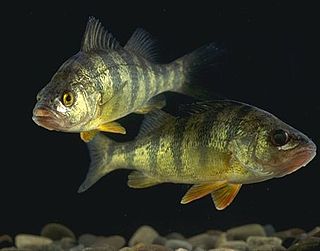
The Percidae are a family of ray-finned fish, part of the order Perciformes, which are found in fresh and brackish waters of the Northern Hemisphere. The majority are Nearctic, but there are also Palearctic species. The family contains more than 200 species in 11 genera. The perches and their relatives are in this family; well-known species include the walleye, sauger, ruffe, and three species of perch. However, small fish known as darters are also a part of this family.
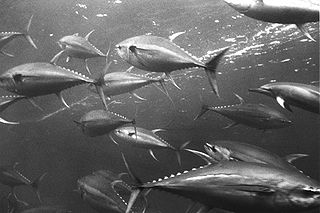
The mackerel, tuna, and bonito family, Scombridae, includes many of the most important and familiar food fishes. The family consists of 51 species in 15 genera and two subfamilies. All species are in the subfamily Scombrinae, except the butterfly kingfish, which is the sole member of subfamily Gasterochismatinae.
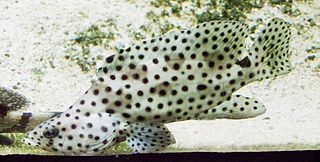
Serranidae is a large family of fishes belonging to the order Perciformes. The family contains about 450 species in 65 genera, including the sea basses and the groupers. Although many species are small, in some cases less than 10 cm (3.9 in), the giant grouper is one of the largest bony fishes in the world, growing to 2.7 m in length and 400 kg (880 lb) in weight. Representatives of this group live in tropical and subtropical seas worldwide.

A sculpin is a type of fish that belongs to the superfamily Cottoidea in the order Perciformes. As of 2006, this superfamily contains 7 families, 94 genera, and 387 species.

The Cottidae are a family of fish in the superfamily Cottoidea, the sculpins. It is the largest sculpin family, with about 275 species in 70 genera. They are referred to simply as cottids to avoid confusion with sculpins of other families.
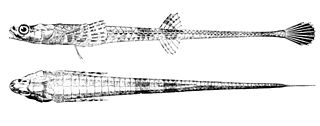
Agonidae is a family of small, bottom-dwelling, cold-water marine fish. Common names for members of this family include poachers, Irish lords, sea ravens, alligatorfishes, starsnouts, hooknoses, and rockheads. They are notable for having elongated bodies covered by scales modified into bony plates, and for using their large pectoral fins to move in short bursts. The family includes about 59 species in some 25 genera, some of which are quite widespread.
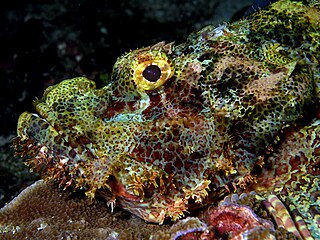
The Scorpaenidae are a family of mostly marine fish that includes many of the world's most venomous species. As their name suggests, scorpionfish have a type of "sting" in the form of sharp spines coated with venomous mucus. The family is a large one, with hundreds of members. They are widespread in tropical and temperate seas but mostly found in the Indo-Pacific. They should not be confused with the cabezones, of the genus Scorpaenichthys, which belong to a separate, though related, family, Cottidae.

Groupers are fish of any of a number of genera in the subfamily Epinephelinae of the family Serranidae, in the order Perciformes.

Combtooth blennies are blenniiformids; percomorph marine fish of the family Blenniidae, part of the order Blenniiformes. They are the largest family of blennies with around 401 known species in 58 genera. Combtooth blennies are found in tropical and subtropical waters in the Atlantic, Pacific and Indian Oceans; some species are also found in brackish and even freshwater environments.

Sebastes is a genus of marine ray-finned fish belonging to the subfamily Sebastinae part of the family Scorpaenidae, most of which have the common name of rockfish. A few are called ocean perch, sea perch or redfish instead. They are found in the Atlantic and Pacific Oceans.

Cardinalfishes are a family, Apogonidae, of ray-finned fishes found in the Atlantic, Indian, and Pacific Oceans; they are chiefly marine, but some species are found in brackish water and a few are found in fresh water. A handful of species are kept in aquariums and are popular as small, peaceful, and colourful fish. The family includes about 370 species.

Stichaeidae, the pricklebacks or shannies, are a family of marine ray-finned fishes in the suborder Zoarcoidei of the order Scorpaeniformes. Most species are found in the North Pacific Ocean with a few in the North Atlantic Ocean.

Tetraroginae is a subfamily of marine ray-finned fishes, commonly known as waspfishes or sailback scorpionfishes, belonging to the family Scorpaenidae, the scorpionfishes and their relatives. These fishes are native to the Indian Ocean and the West Pacific. As their name suggests, waspfishes are often venomous; having poison glands on their spines. They are bottom-dwelling fish, living at depths to 300 metres (980 ft). These creatures usually live in hiding places on the sea bottom.
Alloblennius anuchalis is a species of combtooth blenny in the genus Alloblennius. It is a tropical blenny found in the western Indian Ocean, around Mauritius and Oman. Males can reach a maximum standard length of 2.4 centimetres. The species is oviparous.

The Gobionellinae are a subfamily of fish which was formerly classified in the family Gobiidae, the gobies, but the 5th Edition of Fishes of the World classifies the subfamily as part of the family Oxudercidae. Members of Gobionellinae mostly inhabit estuarine and freshwater habitats; the main exception is the genus Gnatholepis, which live with corals in marine environments. The subfamily is distributed in tropical and temperate regions around the world with the exception of the northeastern Atlantic Ocean, the Mediterranean Sea, and the Ponto-Caspian region. It includes around 370 species and 55 genera: Wikipedia articles about genera list about 389 species.

The Apogoninae are the most species-rich and, of its shape, size, color and habitat, most diverse subfamily of cardinalfishes (Apogonidae). It can be found in coastal tropical and subtropical regions of the Indian Ocean, the eastern Pacific and the Atlantic, down to depths of 300 meters.

Haemulinae is a subfamily of the Haemulidae and consists of the genera of that family which are regarded as being of New World origin, although they are now widespread. The subfamily is distinguished from the Plectorhynchinae by having a short dorsal fin which contains 13-16 soft rays, as opposed to the long dorsal fin with 17-26 soft rays of the subfamily Plectorhynchinae.

The Halophryninae is a largely Old World subfamily of toadfish, part of the family Batrachoididae.

Pomacentrinae is one of four subfamilies in the family Pomacentridae which includes the clownfishes and the damselfishes. It is the most diverse of the subfamilies in the Pomacentridae with around 21 genera and approximately 200 species.

Blenniinae is one of two subfamilies in the combtooth blenny family Blenniidae, it is the smallest of the two subfamilies in the Blennidae with 16 genera and 95 species.



















